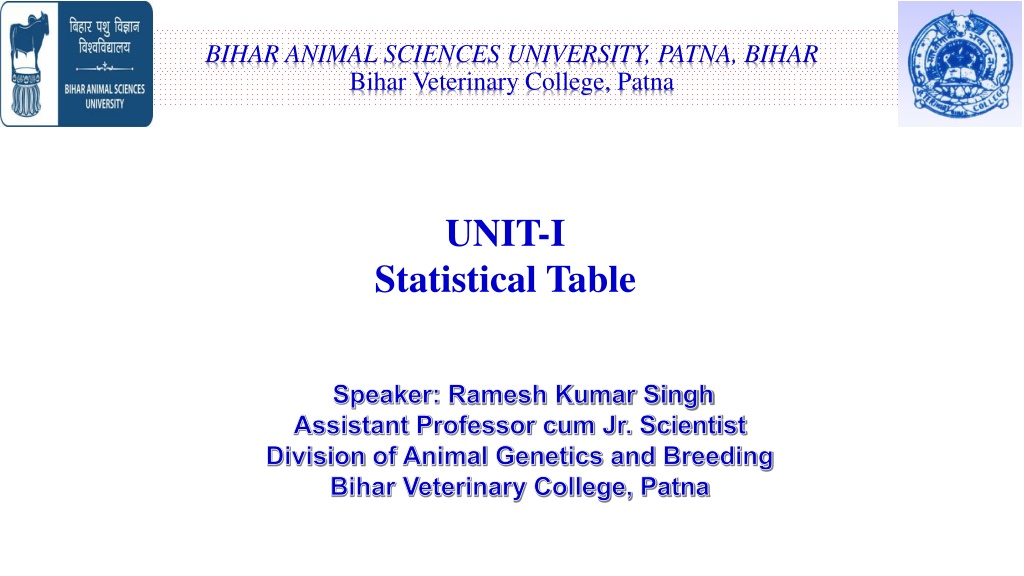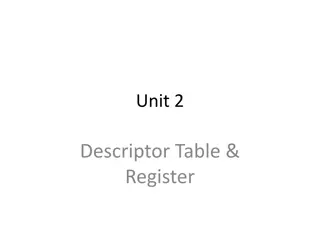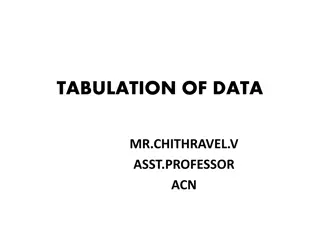Introduction to Statistical Table Tabulation at Bihar Veterinary College, Patna
A statistical table is a systematic arrangement of data that organizes quantitative information for easy comprehension and comparison. It plays a crucial role in data analysis and interpretation, providing a clear representation of data through columns, rows, captions, stubs, and footnotes. Learn about the parts of a table, objectives of classification, requisites of good tables, types of tables, and more. Explore the significance of tabulation in simplifying complex data, facilitating comparisons, economizing space, and aiding statistical analysis for effective decision-making.
Download Presentation

Please find below an Image/Link to download the presentation.
The content on the website is provided AS IS for your information and personal use only. It may not be sold, licensed, or shared on other websites without obtaining consent from the author. Download presentation by click this link. If you encounter any issues during the download, it is possible that the publisher has removed the file from their server.
E N D
Presentation Transcript
BIHAR ANIMAL SCIENCES UNIVERSITY, PATNA, BIHAR Bihar Veterinary College, Patna UNIT-I Statistical Table Speaker: Ramesh Kumar Singh Assistant Professor cum Jr. Scientist Division of Animal Genetics and Breeding Bihar Veterinary College, Patna
Statistical Table Tabulation may be defined systematic arrangement of data in columns and rows. A statistical table is the logical listing of related quantitative data in vertical columns and horizontal rows of numbers with sufficient explanatory, qualifying words, phrases and statements in the form of titles, heading and notes to make clear the full meaning of data and their origin. Tabulation is the final stage in collection and compilation of the data and forms the gateway for further statistical analysis and interpretations. Tabulation make the data comprehensible and facilitates comparisons and the work for further statistical analysis.
Parts of Table Table No.: - Easy identification and future reference Title: - It includes (i) nature of data (ii) time span of data (iii) its geographical locations Head notes or prefatory notes Captions: - It refers to headings of vertical columns or sub columns Stubs: - It refers to headings of rows or sub rows Body of the table: - It contains data which are arranged as per captions and stubs. Foot note: - It anything is unexplained anywhere else in table Source note it secondary data is used
Typical Table Table no. Title Head Note: - Eq units of measurements etc. Stub Heading Caption Total Column Column Column Stub Entries Total Foot note:
Objectives of classification To simplify complex data To facilitate comparisons To economise space To depict trend and pattern of data To help reference as source for future study To facilitate statistical analysis
Requisites of good tables: - Table comprehensive. It should be complete and self-explanatory. It should have an attractive get up. Classification in data should be in proper way. should be simple and compact and readily
Types of table On the basis of originality of data Primary table Derived table On the basis of coverage Simple table data is classified with respect to single characteristics. It gives information about one or more groups of independent questions. Complex tabulation: - It shows the division of data in two or more categories and is meant to give information about one or more sets of inter related questions.






















